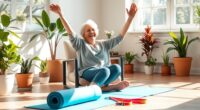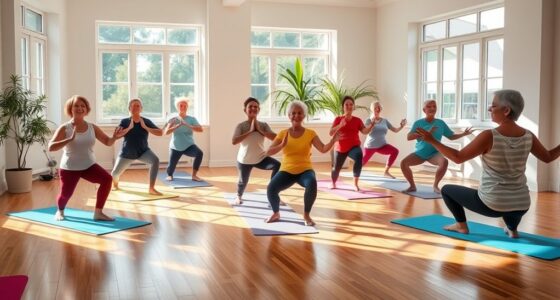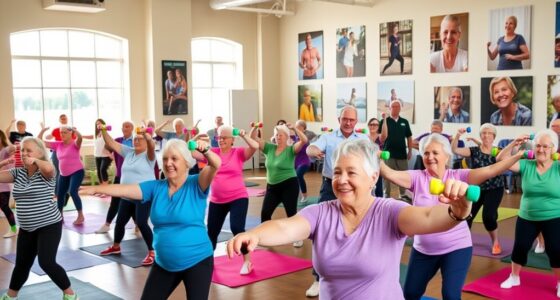Chair fitness for seniors provides simple exercises that enhance your mobility, strength, and overall well-being. With moves like shoulder rolls and ankle circles, you can improve flexibility and coordination, making everyday tasks easier. Regular workouts boost your mood and can help alleviate anxiety. Incorporating chair fitness into your routine not only encourages independence but also fosters social interaction. Stick around, and you’ll discover more about how these exercises can transform your life.
Key Takeaways
- Chair fitness enhances mobility, flexibility, and balance, promoting independence and reducing fall risk for seniors.
- Simple exercises like arm curls and leg raises build strength and improve functional mobility.
- Regular workouts stimulate endorphins, enhancing mood and cognitive function while reducing symptoms of depression.
- Consistent routines of 20-30 minutes, including warm-up and cool-down, foster adherence and accountability.
- Group classes provide social interaction, combating loneliness and cultivating a supportive fitness community.
The Importance of Chair Fitness for Seniors
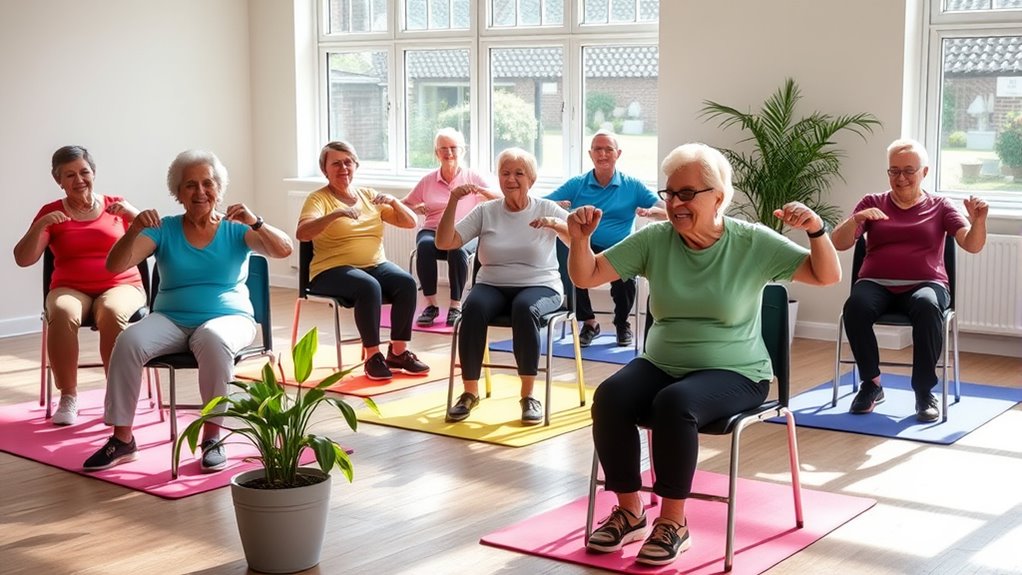
Chair fitness is vital for seniors, especially since it enhances mobility and flexibility, enabling you to maintain your independence. Engaging in chair exercises can greatly improve your balance and coordination, reducing the risk of falls—a common concern as you age. Additionally, establishing consistent routines can help reinforce these benefits, making it easier to stick to your exercise regimen. Studies have shown that digital literacy programs can encourage playful communication, which can also apply to staying engaged in fitness activities.
With simple routines like lifting one leg or using one arm to perform strength exercises, you can effectively promote cardiovascular health and manage blood pressure. Regularly watching exercise videos can guide you through these movements, ensuring you stay motivated and engaged. Plus, these workouts help prevent muscle atrophy and maintain bone density, essential for your overall health. Incorporating chair fitness into your routine not only boosts physical health but also encourages social interaction, enhancing your mental well-being and quality of life. Additionally, participating in support systems such as group classes can provide motivation and foster connections with others.
Warm-Up Exercises to Get Started
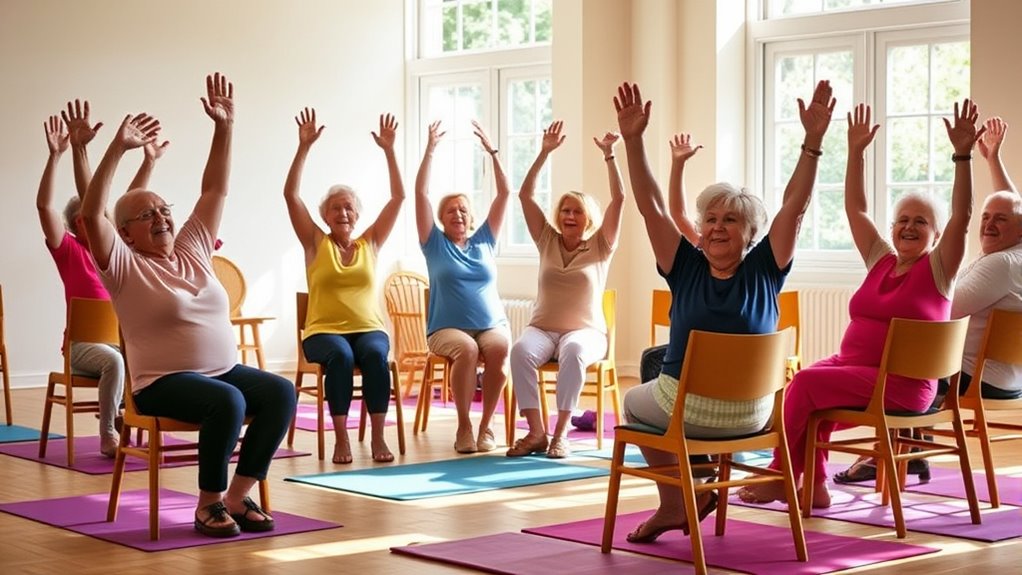
Before diving into your chair fitness routine, warming up is essential to prepare your body for activity. It improves flexibility and reduces the risk of injury.
Warming up is crucial to prepare your body for chair fitness, enhancing flexibility and minimizing injury risks.
Here are three effective warm-up exercises you can start with:
- Shoulder Rolls and Shrugs: Loosen tight muscles in your upper body to enhance mobility and promote better posture. Incorporating these movements can also help mitigate the risk of caregiver burnout. Proper warm-up techniques can lead to a more effective and healthier exercise routine. Engaging in regular physical activity can also promote biodiversity benefits for your overall well-being.
- Wrist Curls and Ankle Circles: These movements help improve joint flexibility and boost circulation, which is vital for maintaining mobility.
- Deep Breathing: Incorporate deep breathing to relax and increase oxygen flow to your muscles, enhancing your performance during exercises. Additionally, proper warm-up can help prevent ear pressure during colds, ensuring a more enjoyable workout experience.
Neck and Shoulder Mobility Workouts
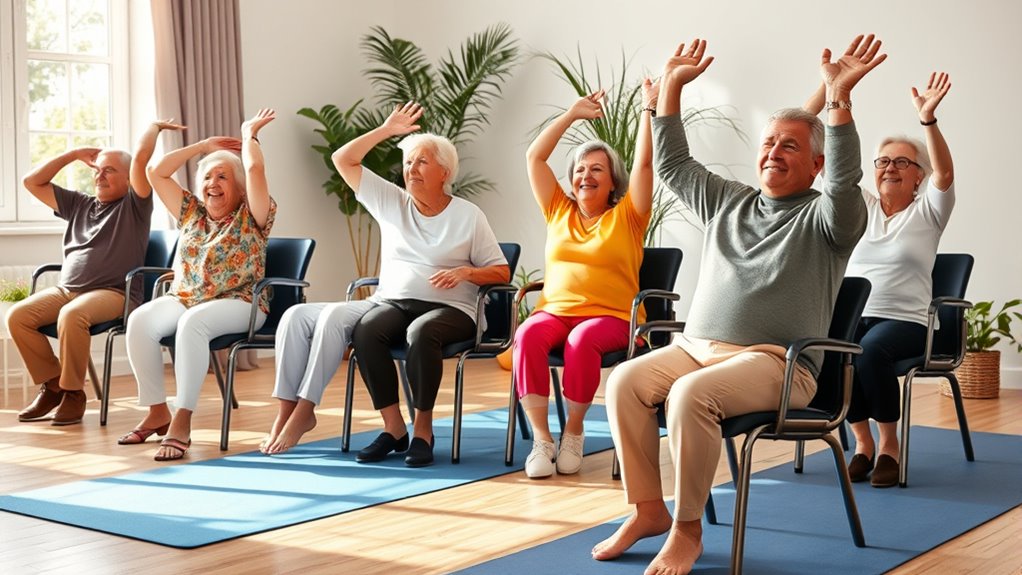
As you focus on enhancing your overall fitness, incorporating neck and shoulder mobility workouts can make a significant difference in your daily life.
Engaging in exercises like neck rotations and shoulder shrugs boosts flexibility and range of motion, essential for maintaining your independence. These simple movements help alleviate tension and lower the risk of injuries from stiffness and poor posture, which is particularly important for seniors facing behavioral challenges. Regular juice cleanses can also support overall wellness by providing a concentrated source of vitamins and antioxidants. Additionally, practicing hydrocolloid patches can help with skin healing, making it easier to feel confident while exercising. Additionally, incorporating rapeseed honey into your diet can enhance energy levels and reduce fatigue, further supporting your fitness journey.
Regularly practicing ear-to-shoulder stretches and chin tucks improves circulation and promotes relaxation, contributing to your overall well-being. Additionally, maintaining strong posture during these exercises can help reduce back pain, which is crucial for overall physical health. Remember to maintain strong posture during these exercises, as it strengthens the muscles supporting your spine, reducing back pain.
Strengthening Your Upper Body and Core
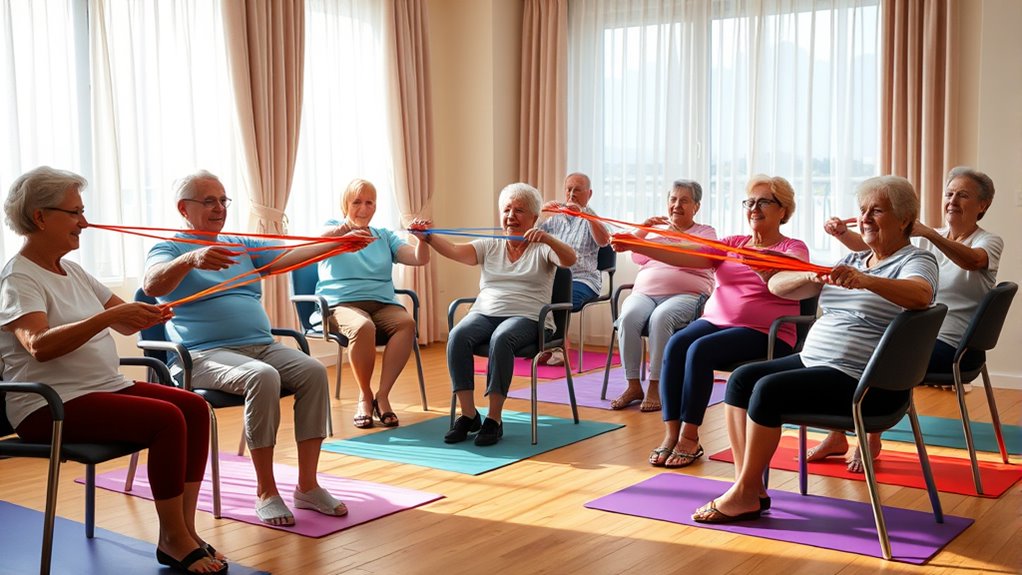
Strengthening your upper body and core is essential for maintaining balance and stability as you age. By focusing on these areas, you can enhance your functional mobility and reduce the risk of falls. Additionally, incorporating mindfulness practices can help you stay focused and motivated during your exercise routine. Practicing self-reflection can also guide you in recognizing your progress and areas for improvement. A balanced approach to fitness includes nutrient-dense meals which can support your energy levels throughout the day. Creating a supportive environment can further enrich your fitness journey and promote holistic living.
Strengthening your upper body and core enhances balance and reduces fall risk as you age.
Here are three effective exercises you can do right in your chair:
- Arm Curls: Use light weights or water bottles, curling them towards your shoulders to build strength.
- Controlled Torso Rotations: Sit tall and gently rotate your torso side to side, improving core stability and coordination.
- Push-ups from Armrests: Press down on your chair’s armrests, engaging your chest and arms for added strength.
Incorporating these movements not only strengthens your muscles but also supports joint function, promoting greater independence in your daily activities. Additionally, a focus on emotional well-being can enhance motivation and consistency in your fitness routine.
Lower Body and Ankle Exercises for Stability
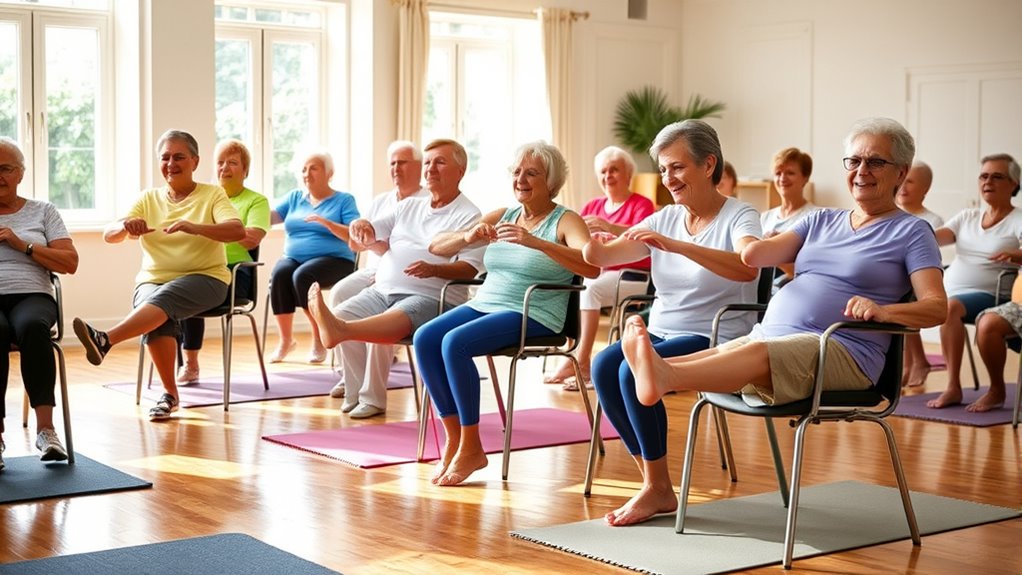
Building on the strength gained from upper body and core exercises, it’s just as important to focus on your lower body and ankles for improved stability. Strengthening the muscles around your hips, knees, and ankles can help prevent falls, which is essential as age increases the risk of injuries. Additionally, individuals with BPD traits may find that physical activity contributes positively to emotional regulation, enhancing overall well-being. Engaging in freelance bartending opportunities can also serve as a fun way to socialize and stay active while promoting good health.
Here are some effective exercises:
| Exercise | Benefits | How to Perform |
|---|---|---|
| Hip Abductions | Improves lateral stability | Sit tall, lift leg to the side |
| Straight Leg Raises | Targets quadriceps and hamstrings | Extend leg straight out, hold |
| Ankle Pumps | Promotes joint flexibility | Flex and point your toes |
| Toe Raises | Strengthens calf muscles | Rise onto your toes |
| Heel Lifts | Enhances stability | Lift heels while seated |
Incorporating these exercises into your routine will help you move confidently and safely. Additionally, maintaining lower body strength is crucial for overall balance and mobility as you age.
Enhancing Flexibility and Range of Motion
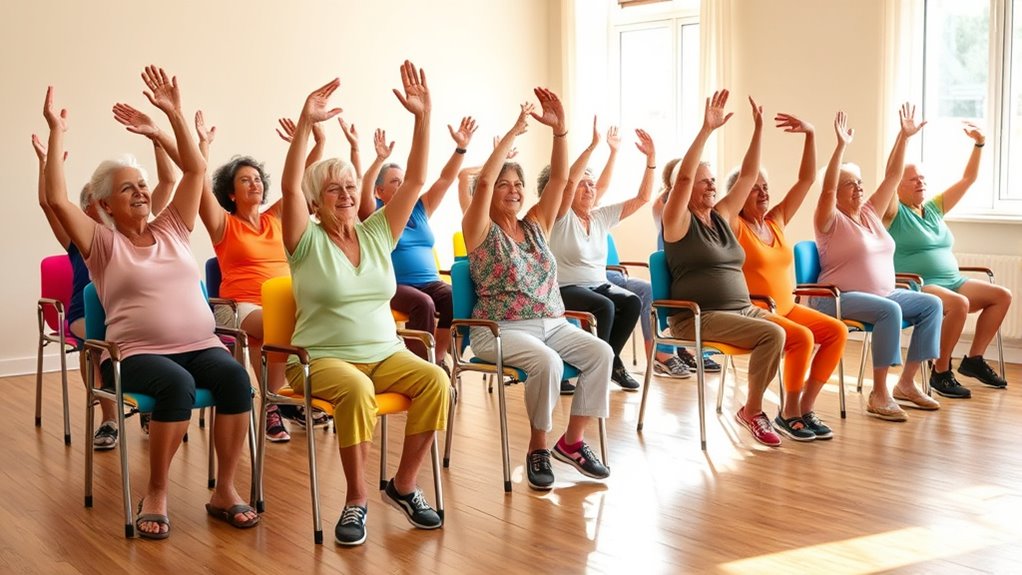
To maintain your independence and enhance your mobility, it’s essential to incorporate flexibility and range of motion exercises into your routine.
Regular flexibility exercises can greatly improve your range of motion and reduce stiffness. Here are three simple exercises to include:
- Neck Stretches and Shoulder Rolls: These help release tension and improve upper body mobility.
- Ankle Circles and Toe Raises: These promote lower body flexibility and enhance balance, helping to prevent falls.
- Hip Flexor Stretches and Leg Raises: These increase hip joint flexibility, vital for activities like walking and climbing stairs.
Cool Down Techniques for Relaxation

After your chair workout, it’s important to wind down properly.
You can practice deep breathing exercises to calm your mind and lower your heart rate.
Additionally, using body relaxation techniques can help you release tension and enhance your overall well-being.
Deep Breathing Exercises
Deep breathing exercises can be a powerful tool for relaxation, especially for seniors looking to unwind after physical activity. They lower stress levels by activating your body’s relaxation response, promoting calmness and well-being.
Just five minutes of deep breathing can notably reduce your heart rate and blood pressure.
To maximize your relaxation benefits, follow these steps:
- Inhale deeply through your nose for a count of four.
- Hold your breath for four seconds.
- Exhale slowly through your mouth for a count of six.
Incorporating these deep breathing exercises into your cool-down routine will help alleviate muscle tension and improve lung capacity, making it an essential practice for overall respiratory health.
Body Relaxation Techniques
While engaging in physical activity is important, incorporating body relaxation techniques helps you unwind and recover effectively.
Start with deep breathing exercises after your workout; these can lower your heart rate and calm your mind, greatly reducing stress. You can also try a body scan technique, focusing on releasing tension from specific muscle groups, which enhances your overall sense of well-being.
Incorporating gentle arm and finger shakes can relieve muscle tightness and improve circulation, further promoting relaxation. Consistent practice of these cool-down techniques, like stretching and deep breathing, not only improves flexibility but also decreases the risk of injury in future workouts.
Remember to maintain an upright posture during these techniques to maximize their benefits.
Creating a Consistent Workout Routine

To create a consistent workout routine, you’ll want to set a schedule that fits your lifestyle and stick to it.
Choose exercises you enjoy to keep things fun and engaging, ensuring you stay motivated.
Finally, tracking your progress can help you see how far you’ve come and keep you accountable along the way.
Set a Schedule
Establishing a consistent workout schedule is essential for reaping the benefits of chair fitness exercises. Aim for at least 3-5 sessions each week to optimize your health.
Here’s how to create your schedule:
- Choose Specific Days and Times: Pick days and times that fit seamlessly into your routine to make workouts a habit.
- Allocate Sufficient Time: Dedicate 20-30 minutes for each session, including warm-up, exercise, and cool-down phases for best results.
- Track Your Progress: Use a calendar or planner to log your sessions, enhancing accountability and encouraging you to stick to your plan.
If possible, invite a friend or family member to join you. This social support can boost your motivation and make exercising more enjoyable!
Choose Enjoyable Exercises
Finding exercises you enjoy is key to maintaining your workout routine. When you choose activities that bring you joy, you’re 90% more likely to stick with them.
Mix things up with chair yoga, dance, or light strength training to keep your workouts exciting and prevent monotony. Consider joining group classes or community programs, where you can enjoy social interactions that boost your mood and create accountability.
Regularly varying the intensity and types of exercises helps target different muscle groups, enhancing overall fitness and reducing injury risks. Plus, set achievable goals related to your favorite activities, like completing a specific number of repetitions.
This sense of accomplishment will motivate you to stay committed to your fitness journey.
Track Your Progress
Tracking your progress is essential for creating a consistent workout routine that keeps you motivated and accountable. Here’s how you can effectively monitor your fitness journey:
- Schedule Regular Sessions: Aim for 3-5 chair fitness sessions per week, lasting 30 minutes each to boost your cardiovascular health and strength.
- Maintain a Workout Journal: Record the exercises you perform, the repetitions, and how you feel before and after each session. This helps you see improvements over time.
- Use a Checklist or Calendar: Visually mark completed workouts to enhance motivation and celebrate your accomplishments.
Reassess your progress every 4-6 weeks to adjust your routine and keep challenging yourself.
This approach guarantees you stay engaged and on track with your fitness goals!
Tips for Staying Motivated
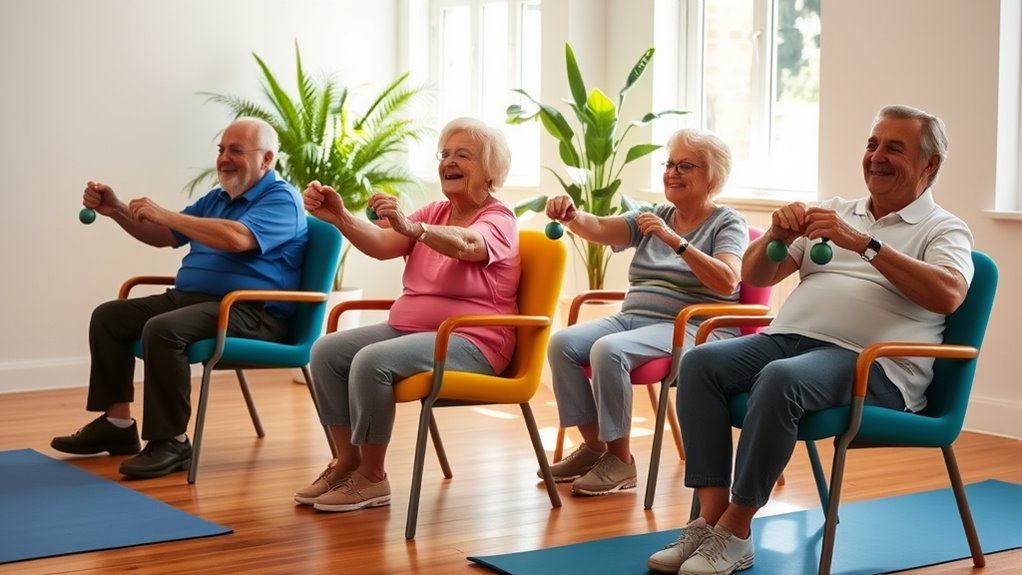
How can you stay motivated in your chair fitness journey? Start by setting achievable fitness goals, like completing a set number of exercises or maintaining a consistent schedule. These small victories give you a sense of accomplishment.
Next, invite friends or family to join your workouts; social interaction makes exercise more enjoyable and holds you accountable. Keep track of your progress with a journal or chart to visualize your improvements over time.
To keep things fresh, vary your routines by introducing new exercises or changing their order. Finally, don’t forget to celebrate small milestones, such as increased flexibility or endurance. These celebrations reinforce positive feelings about staying active and engaged in your fitness journey.
The Benefits of Chair Fitness on Overall Well-Being

Chair fitness can greatly enhance your mobility and flexibility, helping you stay independent and active.
As you strengthen your core stability, you’ll notice improved posture and overall physical function.
Plus, engaging in these exercises boosts your mental health, lifting your mood and fostering social connections.
Enhanced Mobility and Flexibility
Engaging in chair fitness exercises can greatly enhance your mobility and flexibility, making daily activities easier and more enjoyable.
You’ll find that these exercises improve your overall physical health in several ways:
- Increased Range of Motion: Chair exercises help enhance the flexibility of your joints, which is essential for maintaining your independence.
- Reduced Risk of Falls: By promoting better balance and coordination, these activities reduce your chances of falls and injuries.
- Improved Blood Circulation: Regular routines boost circulation, delivering critical oxygen and nutrients to your muscles, enhancing vitality.
As you participate in chair fitness, you’ll likely notice a decrease in stiffness and an overall increase in comfort and quality of life, enriching both your physical and emotional well-being.
Strengthened Core Stability
While you enjoy the benefits of chair fitness, strengthening your core stability plays an essential role in enhancing your overall well-being. Engaging in chair exercises boosts your core strength, which is crucial for maintaining balance and reducing fall risk by up to 30%.
These seated exercises can also alleviate lower back pain by fortifying the muscles that support your spine, improving your mobility and daily function. Additionally, a strong core promotes better posture and alignment, enhancing your respiratory function and energy levels.
As you strengthen your core, you’ll find everyday tasks, like standing up from a chair or walking, become easier. This newfound strength will boost your confidence, encouraging you to participate more actively in social and recreational activities.
Improved Mental Health
Strengthening your core isn’t just about physical benefits; it also plays a significant role in your mental health. Engaging in chair fitness exercises can elevate your mood and enhance your emotional well-being.
Here are some key benefits:
- Endorphin Release: Chair workouts stimulate endorphin production, helping to alleviate symptoms of depression and anxiety.
- Cognitive Boost: Regular exercise improves memory and cognitive function, reducing the risk of cognitive decline by up to 30%.
- Social Interaction: Doing chair fitness in groups combats loneliness and fosters connections, further promoting mental wellness.
Additionally, achieving fitness goals can enhance your self-esteem and confidence, contributing to a more positive outlook on life.
Embracing chair fitness can truly transform your mental health for the better!
Frequently Asked Questions
Do Chair Workouts Actually Work for Seniors?
Absolutely, chair workouts can be effective for seniors. They improve strength, flexibility, and balance, all essential for maintaining independence.
You’ll likely notice enhanced mobility and reduced joint pain, making daily activities easier. Plus, regular participation can boost your cardiovascular health and overall well-being.
Many seniors report feeling happier and less anxious after engaging in these exercises. Since chair workouts can be tailored to your fitness level, you can progress safely and effectively.
What Is the Number 1 Exercise to Increase Balance in Seniors?
The number one exercise to boost balance in seniors is the single-leg stand.
You can improve your stability by challenging your body’s balance system while engaging your core muscles.
Try holding this position for 10-30 seconds on each leg a few times a week.
To make it more challenging, close your eyes or use an unstable surface.
Consistency is key, so integrate this exercise into your daily routine for maximum benefits.
Does the 7 Minute Chair Workout Really Work?
Imagine a tiny spark igniting a roaring fire; that’s what the 7 Minute Chair Workout can do for your health. Yes, it really works!
By engaging in just seven minutes of these chair exercises, you boost your strength, flexibility, and balance. It’s a quick way to elevate your energy, improve your mood, and reduce the risk of falls.
Do Seated Exercisers Work for Seniors?
Yes, seated exercises definitely work for seniors! They’re designed to improve flexibility, strength, and balance, making them a safe choice for those with mobility limitations.
You can enhance your cardiovascular health and overall endurance while reducing the risk of falls. Plus, these workouts can boost your mental well-being by alleviating symptoms of depression and anxiety.
With various options available, you can easily adapt the intensity to match your fitness level.
Conclusion
Chair fitness isn’t just about physical activity; it’s a gentle embrace for your body and spirit. By incorporating these simple moves into your routine, you’re not only nurturing your strength but also celebrating your vibrant journey. Each session brings you closer to a healthier, more confident you. So, let’s cherish every moment spent moving, knowing that every little effort adds up to big results. Embrace this beautiful chapter of life with grace and energy.

